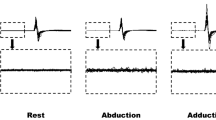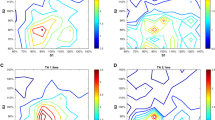Abstract
During individual finger movement, two opposite phenomena occur at the level of the central nervous system that could affect other intrinsic hand muscle representations, unintentional co-activation, and surround inhibition (SI). At rest, excitability in the motor cortex (M1) is inhibited at about 20 ms after electric stimulation of a peripheral nerve [short-latency afferent inhibition (SAI)]. We sought to determine whether SAI changes during selective index finger movement. Effects were measured by the response to transcranial magnetic stimulation in two functionally distinct target muscles of the hand [abductor digiti minimi muscle (ADM), first dorsal interosseus muscle (FDI)]. An increase in SAI in the ADM during index finger movement compared to at rest could help explain the genesis of SI. Electrical stimulation was applied to either the little finger (homotopic for ADM, heterotopic for FDI) or the index finger (heterotopic for ADM, homotopic for FDI). During index finger movement, homotopic SAI was present only in the ADM, and the effect of peripheral stimulation was greater when there was less co-activation. Heterotopic SAI found at rest disappeared with movement. We conclude that during movement, homotopic SAI on the muscle in the surround of the intended movement may contribute to SI.



Similar content being viewed by others
References
Chen R (2004) Interactions between inhibitory and excitatory circuits in the human motor cortex. Exp Brain Res 154:1–10
Classen J, Steinfelder B, Liepert J, Stefan K, Celnik P, Cohen LG, Hess A, Kunesch E, Chen R, Benecke R, Hallett M (2000) Cutaneomotor integration in humans is somatotopically organized at various levels of the nervous system and is task dependent. Exp Brain Res 130:48–59
Delwaide PJ, Olivier E (1990) Conditioning transcranial cortical stimulation (TCCS) by exteroceptive stimulation in parkinsonian patients. In: Streifler MB, Korczyn AD, Melamed E, Youdim MBH (eds) Advances in neurology, vol 53. Raven, New York, pp 175–181
Di Lazzaro V, Oliviero A, Tonali P, Marra C, Daniele A, Profice P, Saturno E, Pilato F, Masullo C, Rothwell JC (2002) Noninvasive in vivo assessment of cholinergic cortical circuits in AD using transcranial magnetic stimulation. Neurology 59:392–397
Engel KC, Flanders M, Soechting JF (1997) Anticipatory and sequential motor control in piano playing. Exp Brain Res 113:189–199
Fish J, Soechting JF (1992) Synergistic finger movements in a skilled motor task. Exp Brain Res 91:327–334
Hager-Ross C, Schieber MH (2000) Quantifying the independence of human finger movements: comparisons of digits, hands, and movement frequencies. J Neurosci 20:8542–8550
Hallett M (2003) Surround inhibition. Suppl Clin Neurophysiol 56:153–159
Kobayashi M, Ng J, Theoret H, Pascual-Leone A (2003) Modulation of intracortical neuronal circuits in human hand motor area by digit stimulation. Exp Brain Res 149:1–8
Lin JZ, Floeter MK (2004) Do F-wave measurements detect changes in motor neuron excitability? Muscle Nerve 30:289–294
Sailer A, Molnar GF, Cunic DI, Chen R (2002) Effects of peripheral sensory input on cortical inhibition in humans. J Physiol (Lond) 544:617–629
Sailer A, Molnar GF, Paradiso G, Gunraj CA, Lang AE, Chen R (2003) Short and long latency afferent inhibition in Parkinson’s disease. Brain 126:1883–1894
Slobounov S, Johnston J, Chiang H, Ray W (2002) The role of sub-maximal force production in the enslaving phenomenon. Brain Research 954:212–219
Soechting JF, Flanders M (1992) Organization of sequential typing movements. J Neurophysiol 67:1275–1290
Sohn Y, Hallett M (2004a) Surround inhibition in human motor system. Exp Brain Res 158:397–404
Sohn YH, Hallett M (2004b) Disturbed surround inhibition in focal hand dystonia. Ann Neurol 56:595–599
Stinear CM, Byblow WD (2003) Role of intracortical inhibition in selective hand muscle activation. J Neurophysiol 89:2014–2020
Tamburin S, Fiaschi A, Andreoli A, Forgione A, Manganotti P, Zanette G (2003) Abnormal cutaneomotor integration in patients with cerebellar syndromes: a transcranial magnetic stimulation study. Clin Neurophysiol 114:643–651
Tamburin S, Manganotti P, Marzi CA, Fiaschi A, Zanette G (2002) Abnormal somatotopic arrangement of sensorimotor interactions in dystonic patients. Brain 125:2719–2730
Tamburin S, Manganotti P, Zanette G, Fiaschi A (2001) Cutaneomotor integration in human hand motor areas: somatotopic effect and interaction of afferents. Exp Brain Res 141:232–241
Tokimura H, Di Lazzaro V, Tokimura Y, Oliviero A, Profice P, Insola A, Mazzone P, Tonali P, Rothwell JC (2000) Short latency inhibition of human hand motor cortex by somatosensory input from the hand. J Physiol (Lond) 523:503–513
Voller B, St Clair Gibson A, Lomarev M, Kanchana S, Dambrosia J, Dang N, Hallett M (2005) Long-latency afferent inhibition (LAI) during selective finger movement. J Neurophysiol 94:1115–1119
Acknowledgements
BV was supported by the Max-Kade-foundation through the Austrian Academy of Sciences. We thank D.G. Schoenberg, M.Sc., for skilful editing.
Author information
Authors and Affiliations
Corresponding author
Rights and permissions
About this article
Cite this article
Voller, B., St Clair Gibson, A., Dambrosia, J. et al. Short-latency afferent inhibition during selective finger movement. Exp Brain Res 169, 226–231 (2006). https://doi.org/10.1007/s00221-005-0140-9
Received:
Accepted:
Published:
Issue Date:
DOI: https://doi.org/10.1007/s00221-005-0140-9




